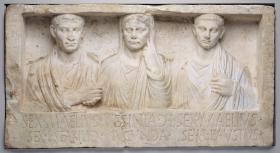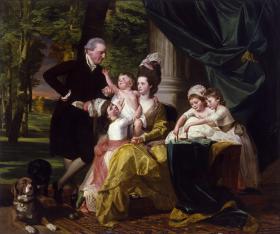- Tell students that today they are going to learn about different kinds of families. Ask students to define family. What makes a person part of your family? How is your neighbor different from your family? Do family members have to live together to be part of your family? Tell students that a family is a group of people who are related to one another. Make a list of people in a family. Include dad, mom, sister, brother, aunt, uncle, cousin, grandfather, and grandmother.
- Read the book Families by Ann Morris. This book shows pictures of families in different countries. Compare and contrast the families in the book. How do the families look? What clues do the pictures give to show that the group is a family? How do you know that they love each other? What are the families doing? Tell students that everyone’s family is alike in some ways and different in other ways. Some families have many children and some have just one. Some families live with grandparents and some do not. Some children live with one parent and some live with more than one.
- Show students Funerary Monument for Sextus Maelius Stabilio, Vesinia Iucunda, and Sextus Maelius Faustus. Tell students that this is a very old sculpture of a family from ancient Rome. Ask students to quietly observe the sculpture for two or three minutes and then be ready to share what they see about this family. Discuss the sculpture. What clues does the sculptor give to show that this is a family? Tell students that the sculpture is showing a husband and wife with their son. Notice how the husband and wife are holding hands.
- Tell students that they will now see a family painted more than 1,000 years after the sculpture was created. Show students the portrait of Sir William Pepperrell (1746-1816) and His Family. Ask students to observe the painting quietly for two or three minutes. Ask students questions to generate class discussion. What clues does the painter give to show that this is a family? How is this family similar to the family in the sculpture? How is it different? How is it similar to or different from your family?
- Hand out magazines, pictures of students with their own families, and other pictures you’ve gathered. Tell students they are going to create a collage of families by using their observation skills. Just as they observed the artworks of families, they can observe pictures to help determine what makes up a family. Remind students that all families look different, but some things are usually the same. Usually the family is close to each other and may be touching. Often family members are smiling and seem to care about one another. Ask students to use their observation skills to find pictures that give clues to show that a group of people is a family. As a class, create a collage with pictures spanning generations and nationalities.
- Allow students to explore the book Families: Around the World, One Kid at a Time by Sophie Furlaud, Pierre Verboud, and Uwe Ommer as time allows.
- Stand back and make observations about families in your class collage. Ask students to share why each picture chosen represents a family.
- Classroom discussion will demonstrate students’ ability to define family as a group of people who are related.
- Classroom discussion will demonstrate students’ understanding that families share common feelings across history and across nations.
- Discussion will demonstrate students’ ability to observe common themes in the sculpture, painting, and pictures found.
- Collaborative collage work will demonstrate students’ understanding of using observation skills to find clues in pictures that indicate people are related as family.
Sculptor: an artist who makes sculptures
Sculpture: the action or art of processing (as by carving, modeling, or welding) plastic or hard materials into works of art
Family: a group of people who are related to one another
Pictures of students with their families
Magazines
Newspapers
Printed pictures of families from around the world
Lesson Resources:
Families by Ann Morris
Families: Around the World, One Kid at a Time by Sophie Furlaud, Pierre Verboud, and Uwe Ommer
This marble relief was carved to fit into the facade of a stone tomb that probably stood along a major road outside Rome. Information about the three people derives both from the Latin inscription at the bottom of the relief and the images themselves. The inscription names the three figures as Sextus Maelius Stabilio, Vesinia Iucunda, and Sextus Maelius Faustus, and indicates that the men were freed slaves of Sextus Maelius and that the woman was freed by a Roman matron named Vesinia. The letter L in the inscription is an abbreviation for libertus, meaning freedman, or liberta, for freedwoman. Such reliefs were often commissioned by recently enfranchised slaves and their families as a way of establishing the social and familial identity and relationships that had been legally denied to them.
The handshake shared by the older man and the woman identifies them as husband and wife. Iucunda also wears a bride’s veil and her betrothal ring, and she holds her left hand to her face in a wife’s traditional gesture of modesty. The younger man is probably the couple’s son, born to them while they were still slaves. He may have been responsible for commissioning this monument. The emphasis on the symbols of marriage evident in this relief reflects the importance attached to the family during the reign of Augustus (31 B.C.E.–C.E. 14 ).
John Singleton Copley was never content with being the finest portrait painter in the American colonies. He fortuitously quit Boston just as revolution was breaking out and settled in London. There he had to refashion his whole style of painting to appeal to aristocratic patrons. One of his first major commissions came from an old Boston acquaintance. Once the wealthiest man in New England, William Pepperrell paid dearly for his loyalty to the Crown. The family was forced into exile, but not before the tragic death of Lady Pepperrell. Thus the portrait Sir William commissioned from Copley is an elaborate fiction, the family made whole again. For the grieving widower and his children, the painting offered a comforting vision of what might have been had not war and death come knocking.



